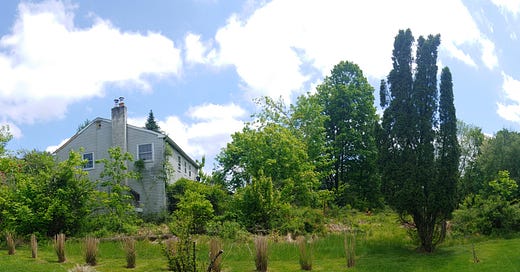It seems that lawns just aren’t cool anymore.
In recent years, anti-lawn sentiment has reached a fever pitch in garden and landscape circles, as waves of groupthink wash up on the shores of every crevice of the gardening internet, the predictable side effects of unexamined intellectual tsunamis within elite media and academia. Even asking an innocent question about controlling dandelions will generally produce a crush of blowback, like “Why would you want to control dandelions? — they’re great for pollinators.” and “Why don’t you remove your lawn and plant wildflowers?”. The extent of the hivemind can sometimes be surreal and disturbing.
Sure, just replace your lawn. Just like that <snaps fingers>.
…as if your kids can play in the wildflower meadow that used to be grass (and, as we all know, there are no ticks and spiders and aggressive wasps in wildflower meadows…).
…as if turning your property into a scene from an episode of Nature will endear you to your neighbors, for whom “natural landscape” is another word for “value-sucking eyesore”.
…as if you have the right to impose your ideology on a neighborhood that you chose to join.
I’ve lived next to a value-sucking eyesore for the past twenty-three years, so I beg your indulgence with a post that dives deep into suburban reality — apparently an area of remedial scholarship in academia. The line between “natural” and “antisocial” can be precarious without a lawn to tether you. But you don’t need to convert your property into a jungle safari to enjoy most of the benefits of a mostly organic, pollinator-friendly landscape — even one that features an attractive and useful lawn.
What does this have to do with “No Mow May”? Well, they emerge from the same intellectual project, and they share common issues and misunderstandings.
Let’s start with some level-setting. I like native plants, though not exclusively (yes, I flirt with attractive, well-behaved foreigners, and I make no apologies for it). I encourage pollinators. I attract as much bird life as I can. I tolerate a reasonable amount of wasp and wood bee activity. I have a 100% organic garden. Elsewhere on the property, I use chemicals sparingly and as a last resort, actively seeking the most natural solution possible. I compost & recycle most yard and kitchen waste. I avoid chemical fertilizers where possible. I maintain a large, pollinator-friendly perennial bed.
I am no stranger to the modern (and mostly correct) sensibility of keeping things as nature-friendly as possible, and avoiding the trap of thinking that chemists and engineers can out-think Mother Nature (spoiler alert: they can’t). But, yes, I have a lawn. A large and gloriously useful lawn. A human construct, descended from Medieval Europe. A garish, ostentatious symbol of gross affluence (NB: I’m not rich). Bourgeois America flexing its flabby arms. It is all those things. And I love it.
My lawn is not part of any large-scale horticultural “problem”. Nothing in my landscape needs to be “fixed”. Oh, sure, it could be better if I didn’t have to work for a living and put five kids through college. But it’s fine. The birds and bees and butterflies and snakes and foxes and voles and squirrels and deer appreciate me. Granted, the mice don’t appreciate me quite so much, but we all have a dark side (if you have had the misfortune of contracting Lyme, you’ll know what I mean).
So why are lawns under assault lately?
Monoculture
Gardeners hear the term “monoculture” a lot these days. It refers to a landscape that is dominated by one particular species. Perfect monocultures are nearly impossible, since all biological organisms depend in some way on a complex ecosystem. But the term is still generally meaningful for discussion purposes. Lawn critics view lawns as monocultural because they are mostly grass, and therefore bad.
In syllogism form:
Monoculture is evil.
Lawns are monocultural.
Therefore lawns are evil.
I would revise this substantially, as follows:
Extreme monoculture isn’t ideal, and counts as a negative in landscape calculus.
Some over-idealized lawns can roughly approximate monoculture, with a lot of effort.
Therefore it is best to manage a lawn responsibly, because…
…lawns elevate human life in multiple ways.
Lest we stumble into a fallacy of equivocation here, I think we need to define our terms carefully. There is a difference between a perfect lawn and a nice, practical lawn. I am here to defend the latter, not the former. No lawn can remain anything close to a monoculture without a lot of effort, expense and chemical intervention. Show me a “perfect” lawn that has been around for more than a couple years, and I’ll show you a soil that is saturated with chemical fertilizers and herbicides. Again, I am not here to defend such things. If your brain is tuned to needing a surreal archetype of a lawn rather than a balanced, healthy lawn, then you need to retune your thinking. If a few weeds and grassy discontinuities wreck your day, you need help, not another bag of Weed ‘n’ Feed. Or maybe you manage a golf course. Or both. Regardless, when it comes to lawns, perfect really is the enemy of the good.
Why is monoculture bad?
Monoculture must be bad in some way, or this discussion would have no antecedent. I have been assuming a lot here, so allow me a brief diversion, for the readers who are not as tuned into modern landscape ideology.
As I suggested earlier, monoculture doesn’t really exist in nature. Most life exists in a complex web, with virtually all living things depending on other living things. Monoculture taxes the balance that healthy ecosystems generally require. And the effects can reverberate.
For various reasons, both logical and aesthetic, humans often find ways to drive landscapes toward monoculture. For example, humans consume a lot of corn. Growing enough corn to meet demand requires unnatural measures (including the corn itself, which has been bred into nearly unrecognizable forms over the centuries). So we grow corn in large corn fields, which, of course, are mostly corn. We take this to an extreme when we plant GMO strains of corn that are modified to tolerate weed killers, which, in turn, allows farmers to tune the monoculture even further.
GMO issues aside, if you plant corn in the same field, year after year, you will destroy the soil and ultimately be unable to grow corn. You will also limit the ecosystem around the field to a microeconomy of plants and animals that can exist in a cornfield. This microeconomy might include deer, mice and some snakes, but probably not a lot of bees (bees do visit corn, but it isn’t their fave destination — corn is mostly pollinated by wind). The corn will crowd out a lot of other plant life that other fauna appreciate, which will reduce the dimensions of life that it can sustain. And when you harvest the corn with a huge machine, well, that’s the end of any ecosystem that might have developed.
If you flood a large geographic area with monoculture, over time you will eventually eliminate entire categories of insects, plants and animals from the area. At the very least, there is opportunity cost with respect to how the land might otherwise flourish. And, as scientists have discovered, the domino effects of removing portions of an ecosystem can be larger than one might predict.
Much more can be said. For now, I am happy to stipulate that artificially-induced monoculture is undesirable at best, particularly if it requires blanketing large areas with petrochemicals and/or fiddling directly with the DNA of the seeds.
Are lawns monocultural?
Strictly speaking, no lawn is a monoculture. Some over-managed lawns come a little too close for comfort, but most typical lawns in the average park or suburban subdivision are not remotely monocultural. Take a close look, and you will find dozens of non-grass species of plants, not to mention multiple species of grasses. From a distance, my lawn looks like grass. But a closer look will change the impression considerably. At different parts of the growing season, you will find multiple grasses, clover, dandelions, oxalis, spurge, nutsedge, violets, crabgrass, creeping charlie, onions, lesser celandine and other species. But from a distance it looks like a nice enough lawn. And it is …nice enough. This is the important point: A “nice enough” lawn has lots of diversity and offers plenty of opportunity for insect life to make a living. And it also offers plenty of opportunity for me, as a human with outdoor interests, to host social gatherings, play with my kids, set up Frisbee golf courses, and just walk around with a cup of coffee before work on fine summer mornings. All that stuff counts in the equation. Human needs and well-being, both individual and social, matter.
A lawn is relatively easy to maintain, compared to the alternatives. And it absorbs lots of water, which is important if you live in an area with questionable drainage, as I do. A lawn also just looks nice, and imbues a sense of civil order within a community. We disregard such issues at our own peril. Lawns have real value beyond the tunnel vision that some people have with insect populations.
But perfect lawns do carry a lot of baggage, and reek of unforced errors. They indeed are mostly grass, often predominantly one type. They require continual infusions of lawn drugs (fertilizers, insecticides and herbicides) to retain their unnatural appearance. And they are highly susceptible to collapse, if this precarious balance is not maintained. Watering cool weather grass species in dry and hot periods, in an attempt to keep them from going dormant, is a waste of water that is better used on other flora in the landscape. Owners of perfect lawns are far more likely to travel this path of horticultural folly. Stipulated. But, again, I’m not trying to defend perfect lawns.
But does any of that even matter?
We are missing a larger point. Properties with lawns can have a lot more going on, in addition to the lawn. Mine certainly does — flowering trees and shrubs, perennials and annuals, mosses, rocky hideaways for snakes and toads, habitat for birds and pollinators, not to mention the vegetable garden. My lawn is one component of a large landscape. It serves a purpose, both to me and wildlife (ask those bees on the clover if they’re not diggin’ my lawn). But the landscape is so much more than just the lawn!
Which brings me to “No Mow May”.
No Mow May is a movement that encourages people to not mow their lawns during the month of May. The theory is that a lot of pollinators come out of hibernation during this time, so wouldn’t it be nice to let all the weeds in our lawns flower and give all the bees something to do when they wake up. Sounds good on the surface, but the reality is quite different.
First, if you don’t mow your lawn until June, it will likely be at least eighteen inches high by the time you mow it. And, well, congratulations, you’ve just destroyed the aesthetics of your lawn for most of the season. Why? Because by then you will be mowing through a large, thickened stalk on each grass plant rather than through the blade. The mowed lawn will look like a bunch of sheared brownish stalks, some of which will die. Yes, the lawn will recover, but it will take time. And if you mow such a lawn with a dull mower blade, the result will look like a chaotic mess, as though hundreds of miniature tornadoes landed in your yard.
Second, most of those now-pollinated weeds that you allowed to grow will go to seed. So your lawn is now on the fast track to becoming mostly weeds. As I said earlier, some weed content is fine, even desirable. But No Mow May will eventually replace most of the grass in your lawn with weeds. And with it goes the aforementioned civil aesthetic.
Third, there just aren’t that many pollinators active in May, relatively speaking, at least earlier in the month. The weather is not uniformly warm yet. There are plenty of plants in a landscape that can meet the needs of all the early risers, without destroying your lawn on behalf of some over-achieving bees. If you’re still worried, plant a perennial garden with some early blooming species.
Fourth, look at a map in satellite mode. Suburban neighborhoods with lawns comprise a small percentage of the land in an area, even in highly populated areas. The bees don’t know anything about property and subdivision boundaries. They don’t mope around waiting for you to read another idealistic, one-sided article about No Mow May. They’re too busy finding the nearest meadow or field or wooded area, bursting with flower nectar. And they know how to fly home. And tell other bees how to find the good stuff. It turns out that bees are really good at being bees. Who knew?
So there is no compelling reason for you to sacrifice your lawn to a six-legged, winged social insect that doesn’t want or need your help. There is no reason to impose a feel-good ideology on your neighbors, who will be forced to look at your property for a month, along with the recovering wreckage for a month or two after that. Even if those newly hatched bees need a boost from humans in May, there are way better ways to provide it. As I write this, my property is hosting countless pollinators that are having a field day with a couple dozen azalea and rhododendron bushes in full bloom. For the couple weeks prior, three fruit trees were the hot spot. And before that, a very large flowering cherry. Before that, daffodils and forsythia did their magic, along with an early flowering cherry and a star magnolia. And, soon, the perennial garden will begin to carry the load. No amount of lawn abuse in May will compare to what these plantings provide to my pollinating friends, from early spring to fall. But even if that were not true, my lawn is already full of blooming clover and other low-growing, non-grass species, whether I mow it or not. In May. Why in the world would I destroy my lawn and annoy my neighbors by not mowing for a month? Because some highly ideological “it guy” with a Ph.D. says so? I don’t think so. Bless his heart.
So what really happens when you let your lawn go native?
I’m glad you asked. Because I have firsthand knowledge. I lived next to a guy for twenty-three years who seemed determined to find out. Now, just to be clear, he didn’t do this out of some grand pursuit of ecological nirvana, or out of some deep altruistic respect of nature. He did it because he was an extremist libertarian who just didn’t care, and who felt no obligation toward his neighbors. And that is how he passed from this world earlier this year, which is sad. But that’s a separate story. The point is, the intentions are irrelevant. The landscape that you neglect with noble purpose does not know or care why you are neglecting it. Nature will do what it does either way. And here are some examples of what nature does, armed with the awesome power of entropy. My, isn’t it lovely?


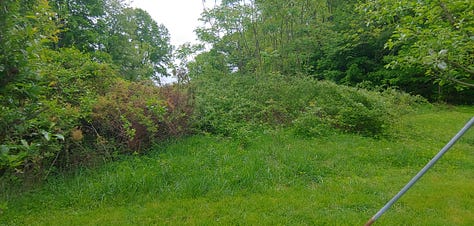
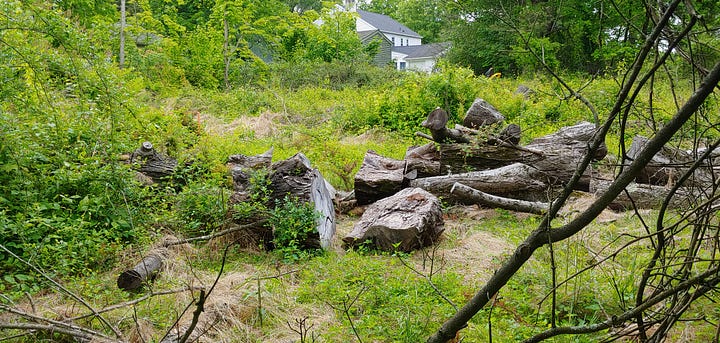
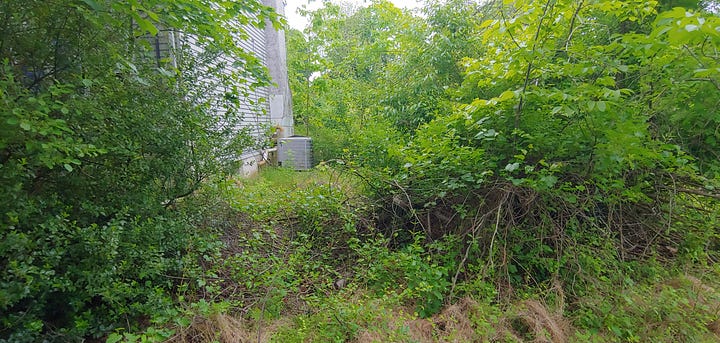

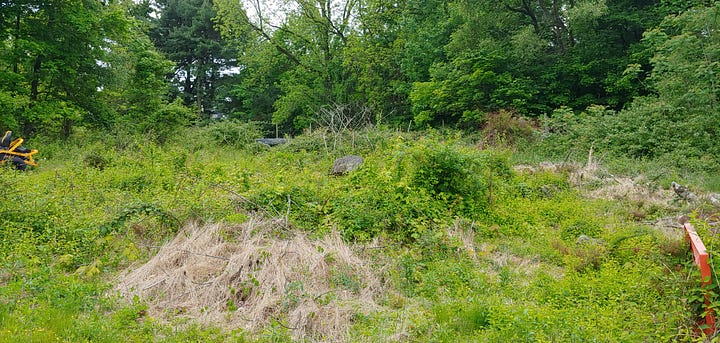
I must emphasize: This was once a lawn. The late owner used to mow parts of it, but gradually allowed most of it to revert to its native state, fully suitable to indigenous flora and fauna. Ain’t that just grand? Do you want to live next to something like this in an otherwise civilized suburban subdivision? I don’t. But I’ve been forced to do just that. This is where ideology leads. Libertarian ideology in this case, but all ideology that is untethered to the full breadth and complexity of reality will yield similar results in its own way.
Some anti-lawn activists will complain (although some will undoubtedly cheer with atavistic glee). They will argue that they don’t mean to replace your lawn with a monstrosity like this. They just want you to plant wildflowers. They will show you idealized photos of well-kept wildflower meadows that used to be front yards. But they don’t tell you that such meadows are on a fast path to the photos above, if you simply leave them alone. It is not a care-free solution. In fact, it is far more work than a lawn. And you will spread aggressive plant species around the neighborhood. Because that’s what many wildflowers do, even the native ones — they reproduce like bunnies and can defeat the slings and arrows of outrageous neglect. In fact, they feed on it.
I cannot emphasize this enough: The photos above are the inevitable destination of any proud and orderly property that is left to seek its natural potential without human management. This is where No Mow May quickly leads if given a deadline extension. And for whom, exactly? And for what? The bees? — which will do just fine with more civilized alternatives. The self-flagellation that must be baked into this kind of thinking is difficult to imagine.
Is there nothing good to say here?
I will now descend from my soapbox so that we can have a less animated conversation. I understand what anti-lawn activists are trying to accomplish. Over the years I have developed a deep respect for the complexity of ecosystems and the human capacity to destroy the delicate equilibria that make them possible. Anyone who reads my gardening advice in other venues knows that my respect for soil approaches fanaticism, largely because so many gardeners commit so many unforced blunders with their soil. The balances can be delicate. The inputs that we inject to these systems can have disastrous effects. For example, when you spray strong insecticides around your property, or apply chemical fertilizers to your garden, you really can spin off chain reactions with all sorts of unintended consequences (which typically require more inputs to remedy, with more consequences). Those things will deplete pollinator populations far more effectively than any reasonable lawn could do.
And so I am not without sympathy for those who bring similar passion to their respect for pollinators. They mean well. We do need to understand and support populations of pollinators in our landscapes. After all, we need pollinators to survive. But you don’t need to destroy or replace your lawn to accomplish that. Anyone telling you otherwise is engaged in pure, idealistic sophistry. All you need to do is supplement your property with pollinator-friendly flora with varying bloom periods, and avoid applying insecticides (even organic ones) near areas where the pollinators gather. If you do those things, you can have your cake and eat it too, without any worry or self-loathing or fear of retribution from the internet anti-lawn thought police.
Ten Rules to Live By in Your Suburban Landscape
Finally, I will offer some constructive recommendations, for those of us who live in suburbia:
When you choose to live in a neighborhood, you commit to abiding by the general standards of the neighborhood. If you don’t like those standards, don’t live there.
You don’t have the right to spread aggressive flora throughout your neighborhood, regardless of whether someone has labeled them “native” or good for pollinators. Plant well-behaved species, native or otherwise.
If you have a lawn, for Pete’s sake, mow the darned thing. Regularly. Do not collect grass clippings. Mulch only. Set the mower height very high. It’s better for the grass, and will allow other species to coexist. An imperfect lawn is not only okay, it is the objective. You don’t need to kill all the weeds.
Don’t broadcast weed killers across your entire lawn. If you must control certain aggressive weeds with chemicals, spot treat with a hand sprayer. But, again, you don’t need to remove all the weeds. Buy a stand-up weeder for excess dandelions. Fiskars makes a couple great ones.
If you have a lawn, don’t fertilize it multiple times a season. In fact, don’t fertilize it at all, particularly if you have fall leaves that you can mow into the soil. If you have no leaves, one light application of fertilizer in the spring or early fall is okay. But, again, mulching fall leaves into the lawn is the best feeding you can provide. Resist the urge to water cool season lawns in the middle of the summer. Use your water elsewhere; the lawn will green up quickly as soon as the rains return.
Create a bird and pollinator friendly landscape. Perennial beds and fruit/flowering trees are pollinator heaven. Learn to appreciate the clover in your lawn. If you dislike it, get over it — it looks nice and the bees love it. Incentivize the birds to hang around year round by hanging suet feeders in the fall and winter.
Realize that chemical fertilizer is rarely if ever the answer to anything. Get in the habit of feeding all your shrubs with compost in the spring. That is all they need for the season.
For the sake of your neighbors, plant only what you can maintain, or can pay someone to maintain. “Simple and well-conceived” is way better than “sloppy and disorganized”. Of course, if you live on a secluded estate, do whatever suits your fancy.
When choosing plants, focus on whether the specimen is aggressive over whether it is native. Native is good, but non-aggressive is better in suburban neighborhoods. If you can check both boxes, all the better. That said, native is more important when choosing spring-flowering trees, as native species tend to be better adapted to seasonal variation, which is important if you’re a tree. Despite the recent hype, planting natives it is not as important with annuals and perennials. The idea that we know what butterfly “junk food” is better than the butterflies do is silly. Bees and butterflies are startlingly good at being bees and butterflies. Plant diverse flowering species that together provide a long bloom period, and all will be well.
Finally, take the time to enjoy the fruits your hard work. Stroll the grounds frequently. Pick bouquets, as the plants fill in. Invite friends over for a cup of coffee or a beer. Exchange ideas. Landscaping in a suburban environment is not just about plants. In fact, it’s not even primarily about the plants. It’s mostly about the humans.
Finally, when you see headlines like the one below in mainstream media outlets (this one is from the Washington Post), my best advice is to just ignore it. I wouldn’t take baking advice from someone who has never separated an egg. And I certainly wouldn’t take lawn maintenance advice from elitist urbanites and academics who have never dealt with real lawns and the dynamics of suburban neighborhoods.


